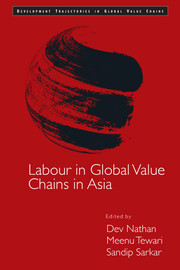Book contents
- Frontmatter
- Contents
- Figures
- Tables
- Foreword
- Preface
- Acknowledgements
- Introduction
- Captive Governance
- 2 Achieving Better Work for Apparel Workers in Asia
- 3 Improving Wages and Working Conditions in the Bangladesh Garment Sector: The Role of Horizontal and Vertical Relations
- 4 Bargaining in Garment GVCs: The Asia Floor Wage
- 5 Fresh Produce Markets, Standards, and Dynamics of Labour: Grapes in India
- 6 The ‘Zero-Fee’ Tour: Price Competition and Chain Downgrading in Chinese Tourism
- 7 Restricting Competition to Reduce Poverty: Impact of the Tourism Value Chain in an Upland Economy in China
- 8 Restructuring of Post-crisis GVCs: Tourism in Bali, Indonesia
- 9 Dynamics of Labour-intensive Clusters in China: Wage Costs and Moving Inland
- 10 Migrant Labour in Global Value Chains in Asia
- Modular Governance
- Relational Governance
- Conclusions
- Notes on Contributors
- Index
4 - Bargaining in Garment GVCs: The Asia Floor Wage
from Captive Governance
Published online by Cambridge University Press: 23 July 2017
- Frontmatter
- Contents
- Figures
- Tables
- Foreword
- Preface
- Acknowledgements
- Introduction
- Captive Governance
- 2 Achieving Better Work for Apparel Workers in Asia
- 3 Improving Wages and Working Conditions in the Bangladesh Garment Sector: The Role of Horizontal and Vertical Relations
- 4 Bargaining in Garment GVCs: The Asia Floor Wage
- 5 Fresh Produce Markets, Standards, and Dynamics of Labour: Grapes in India
- 6 The ‘Zero-Fee’ Tour: Price Competition and Chain Downgrading in Chinese Tourism
- 7 Restricting Competition to Reduce Poverty: Impact of the Tourism Value Chain in an Upland Economy in China
- 8 Restructuring of Post-crisis GVCs: Tourism in Bali, Indonesia
- 9 Dynamics of Labour-intensive Clusters in China: Wage Costs and Moving Inland
- 10 Migrant Labour in Global Value Chains in Asia
- Modular Governance
- Relational Governance
- Conclusions
- Notes on Contributors
- Index
Summary
Introduction
The primary concern of trade unions is to improve wages and working conditions of workers in firms owned by capitalists. Wages are a key component of workers’ well-being and trade unions are concerned with establishing dignified and decent wages for workers and their families. Their endeavours, through a large part of capitalist history, have been directed at establishing decent working conditions and a living wage within national boundaries. The concern for x1a decent wage also serves some important social functions, such as reducing gender wage gap and increasing the wage share, that go beyond the physical well-being of workers and their families. As the recent discussion on inequality points out, the fall of wage share in the 1980s and thereafter affects the stability of the international capitalist system (ILO, 2013; Nathan and Sarkar, 2014). Increasing wages and the share of wages in the wealth created from economic growth is an important part of inclusive growth.
The developing countries of Asia possess a large reserve army of labour in agriculture and the urban informal sector, on account of which establishing living wage levels, even in the organized factory sector, has been a hard-fought battle. However, the evolution of contemporary globalization, with the splitting up of production among different countries in the form of global value chains (GVCs), has changed the arena within which the struggle for living wages takes plaxce. Capital, particularly in GVCs, is mobile, while labour is relatively immobile. GVC-based capital, in particular, seeks to take advantage of the possibility of wage arbitrage that results from Global North capital having dual access to low-wage Global South production markets and to high-value Global North retail markets. With GVC-style functioning, manufacturing or cut-make-trim (CMT) functions in the apparel industry is separated from design, branding, and marketing. The CMT segment of the garment industry is shifted to low-wage locations, such as in the developing countries, which also have or can establish basic manufacturing capabilities. With developing country manufacturers competing for contracts with brands and retailers, the latter are able to utilize this competition to push down Freight-on-Board (FoB) prices for manufacturers.
- Type
- Chapter
- Information
- Labour in Global Value Chains in Asia , pp. 78 - 93Publisher: Cambridge University PressPrint publication year: 2016



